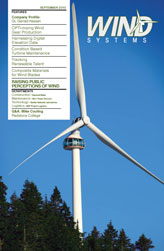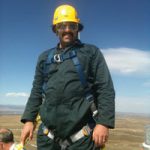What led to the development of your new Wind Energy Technology Program?
Redstone College, which was formerly known as Colorado Aero Tech, has been around for about 45 years, and we offer technical programs such as “Airframe and Powerplant” and “Advanced Electronic Technology.” We provide a “Construction Management” program for that industry, and “Heating & Ventilation, Air Conditioning & Refrigeration” in the industrial services category, so we have a long history of offering training programs targeting a wide variety of fields. We’re one of the nation’s top providers of newly FAA-certified aircraft mechanics, in fact, and we’ve graduated more than 15,000 technicians over the years. A couple of years ago we were briefed by Snap-on Tool executives about the growth of the wind power industry here in the United States and around the world, and we discussed their plans to be a major tool supplier for the industry.
After much research we decided the time was right to introduce a training program for wind technicians. We sought the input of industry giants, including Vestas, which has three manufacturing facilities nearby, and also the American Wind Energy Association, which we’ve joined, and we’re pulling together a professional advisory committee to help us keep our curriculum current in the coming years. It has been our goal from the very beginning to have a great deal of involvement and interaction with the key players in the wind industry.
Who is eligible to enter the program, and what will they learn?
First of all, anyone can apply as long as they have a high-school diploma or have passed their GED. We had more than 60 people apply for the first class, which began its program of study on August 5 and will last for 15 months, and they were made up of everyone from recent high-school graduates to those in mid-career who are interested in developing new skills and making a change. The program is divided into six terms, and in the beginning students will learn the basics of electrical theory before taking an introduction to wind energy in the third term, which discusses its history as well as the mechanics and design of turbines and towers.
During the remaining three terms we’ll really get into the heart of the matter, including the design of wind turbines, blades, pitch, rotors, and other mechanisms, and then we’ll cover more having to do with electronics such as AC/DC fundamentals, solid state theory, and digital electronics. Toward the end of the course we’ll get into inspection and troubleshooting, and then we’ll conclude with wind turbine safety training, including climb and fall safety, emergency rescue, fire safety, and CPR. Those completing the program will receive an associate of occupational studies degree, along with any certifications they require.
Tell us about your facilities, and what will be available for student training.
Knowing that Vestas is such a big player in the wind industry worldwide, we wanted to have equipment that would provide the best hands-on training, so we purchased a previously-owned Vestas V-27 225kW turbine. We have the nacelle on the ground so that it can accommodate larger classes, and we also have a 33-foot section of tower where we’ll conduct different safety exercises. As for employers, we feel that we’ll be a great resource for the industry, providing manufacturers, O&M providers, and many others with qualified technicians from our centrally-located campus here in Denver, Colorado.
With our proven track record in the aviation industry, and the tremendous growth of the wind industry both here in North America and abroad, we look forward to playing a role in supporting the growth of the renewable energy market. In fact, the latest stats provided by AWEA state that a new wind technician is needed for every newly installed 10MW of wind capacity. In 2009 over 500 new technicians would have been needed. With the current U.S. initiative of reaching 20 percent electricity from wind energy by the year 2030, some 30,000 new technicians will be needed. Redstone College is excited about the growth of this energy segment, and we stand ready to train these new technicians.
To learn more: Call (877) 801-1025 or visit www.redstone.edu.








































